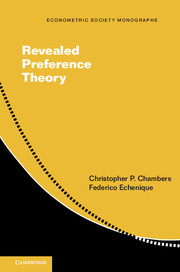Book contents
- Frontmatter
- Dedication
- Contents
- Preface
- 1 Mathematical Preliminaries
- 2 Classical Abstract Choice Theory
- 3 Rational Demand
- 4 Topics in Rational Demand
- 5 Practical Issues in Revealed Preference Analysis
- 6 Production
- 7 Stochastic Choice
- 8 Choice Under Uncertainty
- 9 General Equilibrium Theory
- 10 Game Theory
- 11 Social Choice and Political Science
- 12 Revealed Preference and Systems of Polynomial Inequalities
- 13 Revealed Preference and Model Theory
- References
- Index
- Miscellaneous Endmatter
7 - Stochastic Choice
Published online by Cambridge University Press: 05 January 2016
- Frontmatter
- Dedication
- Contents
- Preface
- 1 Mathematical Preliminaries
- 2 Classical Abstract Choice Theory
- 3 Rational Demand
- 4 Topics in Rational Demand
- 5 Practical Issues in Revealed Preference Analysis
- 6 Production
- 7 Stochastic Choice
- 8 Choice Under Uncertainty
- 9 General Equilibrium Theory
- 10 Game Theory
- 11 Social Choice and Political Science
- 12 Revealed Preference and Systems of Polynomial Inequalities
- 13 Revealed Preference and Model Theory
- References
- Index
- Miscellaneous Endmatter
Summary
We now study the empirical content of individual rational choice when choice is stochastic. There are two possible interpretations of this exercise.
The first is that we lack data on individual choices. There is instead a population of agents, and we observe the distribution of choices in the population. For example we may know how many people purchased Italian wine in a wine store, and how many purchased French cheese in a cheese store, but we do not know if those who bought the French product in one store are the same people who bought Italian in the other. The theory to be tested is that of rational agents with stable preferences. Thus we want to know when an observed distribution of choices is consistent with a population of rational agents with potentially different, but stable, preferences.
The second interpretation is that we observe an individual who literally randomizes among different alternatives. We might observe this individual agent over time, enough to infer a stochastic rule that he uses to select an element at random when faced with a given set of available choices.
STOCHASTIC RATIONALITY
The model of stochastic choice can be described as follows. A system of choice probabilities is a pair (X,P), where X is a finite set of alternatives and P is a function with domain contained in 2X\﹛∅﹜ × X, where P(A,x) = PA(x) is a non-negative number for each nonempty A ⊆ X and x ∈ A, and such that ∑x∈A PA(x) = 1. In other words, PA(x) defines a probability distribution over the set A.
In our first interpretation of stochastic choice, there would be an underlying large population of agents: PA(x) is the fraction of agents who choose x when the set A of possible alternatives is available. In the second interpretation of stochastic choice, an individual agent's choices really are random, and we know that PA(x) is her probability of choosing x from A.
- Type
- Chapter
- Information
- Revealed Preference Theory , pp. 95 - 113Publisher: Cambridge University PressPrint publication year: 2016

